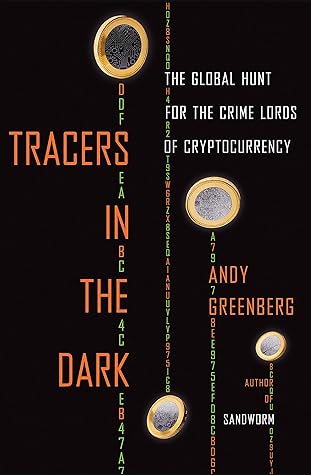More on this book
Community
Kindle Notes & Highlights
Read between
February 4 - February 11, 2024
That lawlessness left a deep mark on Gambaryan—as well as an almost zealous, black-and-white starkness to his ideas of criminality. Even today he says the sense remains with him that there are real elements of corruption and chaos in every society, that the “law of the land” he witnessed in Moscow lies just beneath the surface, everywhere, ready to emerge whenever people have a sense of impunity from consequences. “Americans don’t know how good they have it,” Gambaryan says. “You let it slip, it turns into the chaos that I saw.”
As an IRS investigator tasked with following the money, he considered the notion of anonymous digital cash vaguely foreboding. Who would pay taxes on these “anonymous” transactions? Wouldn’t Bitcoin become the perfect money-laundering tool?
As radical as Andresen’s dreams for Bitcoin’s future value might have been, it was something else he said that got my attention: his brief description, almost in passing, of Bitcoin’s pseudonymous creator, Satoshi Nakamoto, as “this mysterious guy who was definitely inspired by the cypherpunks.” The cypherpunks were, as I’d been obsessively researching at the time, a group of radical libertarians who had formed in the 1990s, unified around the grand mission of using unbreakable encryption software to take power away from governments and corporations and give it to individuals.
Nakamoto’s invention, Bitcoin, was finally that crypto-anarchist holy grail: truly anonymous, untraceable, and practical digital money.
Bitcoin’s creator disappeared from the internet less than two weeks after my article appeared, never to return. Their identity remains unknown—one of the greatest mysteries in the history of technology.
Tor was the dark web’s active ingredient, providing a kind of double-blind anonymity. It was designed so that anyone could visit a dark web site who knew the site’s address—a long and random-seeming string of characters. But no visitor to that site could see where it was physically hosted, nor could the site identify the location of its visitors. Any third party snooping on their connection could learn nothing about the locations of the computers on either end.
In attempting to shut down the Bitcoin black market, Schumer had inadvertently given it its best publicity yet.
“Silk Road doesn’t really sell drugs, it sells insurance and financial products,” the Carnegie Mellon computer engineering professor Nicolas Christin put it at the time, expressing his amazement at the Silk Road’s smooth management of online transactions in an entirely new, anonymous medium. “It doesn’t really matter whether you’re selling T-shirts or cocaine. The business model is to commoditize security.”
the person, the enterprise, everything. But I need a name.” He revealed the one he’d chosen: “Dread Pirate Roberts.”
There was a maxim in cryptography, often referred to as Schneier’s law after the cryptographer Bruce Schneier. It asserted that anyone can develop an encryption system clever enough that they can’t themselves think of a way to break it. Yet, like all the best conundrums and mysteries that had fascinated Meiklejohn since childhood, another person with a different way of approaching a cipher could look at that “unbreakable” system and immediately see a way to crack it and unspool a whole world of decrypted revelations.
But that blockchain ledger system came at an enormous privacy cost: In Bitcoin, for good and for ill, everyone was a witness to every payment.
The blockchain, like a massive, undeciphered corpus of an ancient language, hid a wealth of secrets in plain view.
she and the other researchers on the team had explicitly suggested in their paper that a law enforcement agency with subpoena authorities could easily identify criminal activity on the blockchain. But she was turned off by the aggressive tone of the agents in the room: They began describing the anonymity software Tor simplistically, as a haven of crime and abuse that prevented them from catching bad actors. Meiklejohn saw Tor as an essential privacy tool. She knew, for instance, that it was used by millions of people around the world, often living under repressive regimes, to attain a modicum
...more
For a moment, Gambaryan and Der-Yeghiayan sat on the phone in silence. Gambaryan had just, for the very first time in a U.S. criminal investigation, traced cryptocurrency payments to prove someone’s guilt. “Oh, shit,” Gambaryan remembers thinking. “We broke Bitcoin.”
But the day when the prosecution found the incontrovertible, public, and unerasable proof of Ulbricht’s Silk Road millions, argues Nick Weaver, remains a milestone in the history of cryptocurrency and crime. “That is the date,” Weaver says, “that you can state unequivocally that law enforcement learned that the blockchain is forever.”
Gronager wanted, in fact, to take sole responsibility for the most challenging part of tying up Mt. Gox’s loose ends: He would find Mt. Gox’s missing coins. This promise was hugely ambitious—not least because Gronager had barely coded a working prototype of Chainalysis’s software. But there would be no better motivation to perfect it, he figured, than taking on the biggest unsolved criminal case in the history of cryptocurrency.
describe Force and Bridges’s double corruption case as “lightning striking twice.” But looking again at the temptation of cryptocurrency as Gambaryan had come to see it—a black hole of seemingly consequence-free financial corruption—perhaps it’s no surprise that more than one agent had succumbed. The two men, like the Dread Pirate Roberts they were hunting, had been seduced by the same siren song: the false promise of untraceable money.
“Every Bitcoin user has access to the public Bitcoin blockchain and can see every Bitcoin address and its respective transfers. Due to this publicity, it is possible to determine the identities of Bitcoin address owners by analyzing the blockchain,” the ruling read. “There is no intrusion into a constitutionally protected area because there is no constitutional privacy interest in the information on the blockchain.”


